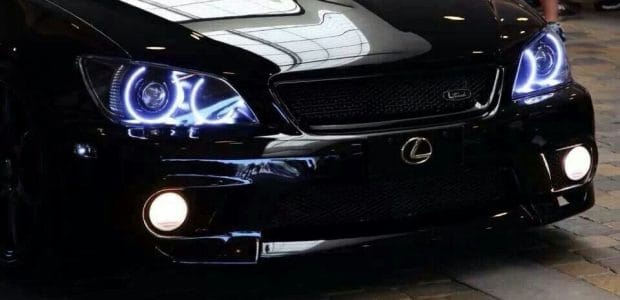If you’re considering upgrading your vehicle with LED halo lights, the first question on your mind is probably: “Are these modifications actually legal?” You’re not alone in this concern. With over 50,000 automotive enthusiasts already installing LED halo kits nationwide, understanding the legal landscape is crucial before making your purchase.
LED halo lights have revolutionized vehicle customization, offering everything from Bluetooth-controlled RGB lighting to sophisticated color-changing capabilities. However, automotive lighting laws vary significantly across states, and what’s perfectly legal in one location might result in a citation in another.
This comprehensive guide will break down the legal status of LED halo lights in all 50 states, explain the key regulations you need to know, and provide practical tips for staying compliant while achieving that head-turning look you want. Whether you’re planning a Dodge Charger halo kit installation or considering RGB lighting upgrades for your truck, this article will ensure you stay on the right side of the law.
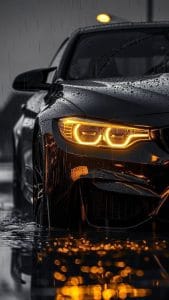
Understanding Federal vs State Lighting Regulations
Federal Motor Vehicle Safety Standards (FMVSS)
At the federal level, the Department of Transportation (DOT) sets baseline standards for automotive lighting through FMVSS 108. These regulations establish minimum requirements for headlights, taillights, and other essential lighting components. However, federal standards don’t specifically address aftermarket modifications like LED halo rings.
The key federal requirements include:
- Headlights must produce white or amber light
- Red lighting is restricted to the rear of the vehicle
- No flashing lights except for emergency vehicles
- Proper beam patterns and intensity levels
State Authority Over Vehicle Modifications
While federal standards provide the foundation, individual states have the authority to impose stricter regulations on vehicle modifications. This is why you’ll find significant variations in LED halo light legality across different states. Some states embrace automotive customization, while others maintain strict restrictions on any aftermarket lighting modifications.
State regulations typically focus on:
- Color restrictions (which colors are permitted)
- Placement requirements (where lights can be mounted)
- Usage limitations (when lights can be activated)
- Intensity restrictions (brightness levels allowed)

State-by-State Legal Analysis
Permissive States (Generally Legal)
Texas Texas leads the nation in automotive customization freedom. LED halo lights are generally legal as long as they don’t interfere with required lighting and aren’t visible while driving on public roads. The key restriction is that decorative lighting cannot distract other drivers or impair the vehicle’s required lighting systems.
Nevada Nevada allows LED halo lights with minimal restrictions. The primary requirement is that aftermarket lighting cannot flash or strobe while the vehicle is in motion. RGB halo kits are permitted as long as they display steady colors.
Arizona Arizona permits LED halo lights but prohibits red or blue colors on the front of the vehicle. White, amber, and other colors are generally acceptable. The state focuses more on the functionality of required lighting rather than restricting decorative additions.
Florida Florida allows LED halo lights with some color restrictions. Blue and red lights are prohibited for civilian vehicles, but white, amber, and other colors are typically acceptable. The lights must not interfere with the vehicle’s standard lighting systems.
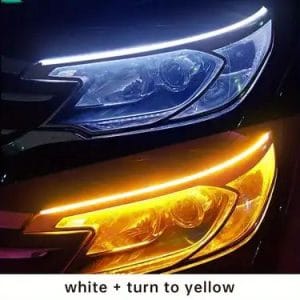
Moderately Restrictive States
California California’s approach to LED halo lights is nuanced. While not explicitly illegal, the lights must comply with strict color and brightness regulations. Only white or amber light is permitted on the front of vehicles, and the lights cannot exceed certain intensity levels. Many RGB halo kits can be made compliant by limiting color options while driving.
New York New York allows aftermarket lighting modifications but requires that they don’t interfere with required vehicle lighting. LED halo lights are generally acceptable if they’re properly installed and don’t distract other drivers. The state prohibits flashing or rotating lights on civilian vehicles.
Illinois Illinois permits LED halo lights with standard color restrictions. No red or blue lighting on the front, and the modifications cannot impair the vehicle’s standard headlight function. Proper installation is crucial to maintain compliance.
Ohio Ohio takes a practical approach to LED halo modifications. The lights are legal as long as they meet federal standards and don’t create safety hazards. This includes ensuring proper headlight function and avoiding distracting colors or patterns.
Restrictive States
Virginia Virginia maintains strict regulations on vehicle lighting modifications. While not completely prohibited, LED halo lights must comply with stringent color and placement requirements. Only white or amber light is permitted on the front of vehicles, and the modifications must not affect required lighting systems.
Connecticut Connecticut requires that all vehicle lighting modifications pass state inspection. LED halo lights are possible but must be properly installed and comply with all state regulations. This often requires professional installation and documentation.
Massachusetts Massachusetts allows LED halo lights but requires they meet specific technical standards. The lights must not interfere with required vehicle lighting and cannot exceed certain brightness levels. Color restrictions apply, limiting front lighting to white or amber.
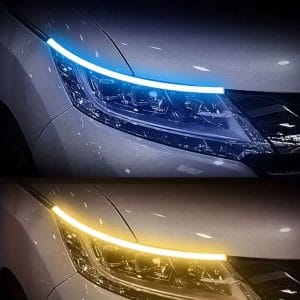
Key Legal Considerations for LED Halo Lights
Color Restrictions Explained
Understanding color restrictions is crucial for LED halo light compliance:
Universally Prohibited Colors:
- Red lighting on the front of vehicles (reserved for emergency vehicles)
- Blue lighting (typically reserved for law enforcement)
- Green lighting (often restricted to emergency or government vehicles)
Generally Accepted Colors:
- White (most universally accepted)
- Amber/Yellow (widely permitted)
- Purple (allowed in many states)
- Pink (permitted in most jurisdictions)
Brightness and Intensity Regulations
Many states regulate the intensity of aftermarket lighting to prevent driver distraction and maintain road safety. Key considerations include:
- Candela ratings must not exceed certain thresholds
- Lights cannot create glare that impairs other drivers
- Beam patterns must not interfere with required headlight function
- Some states require dimming capabilities for aftermarket lighting
Usage Restrictions
Even in states where LED halo lights are legal, there may be usage restrictions:
While Driving:
- Many states require decorative lighting to be turned off while on public roads
- Some jurisdictions allow parking light mode only
- RGB functionality may need to be limited to specific colors
Parked or Show Use:
- Most states allow full functionality when parked
- Car shows and private property typically have no restrictions
- Off-road use generally permits all features
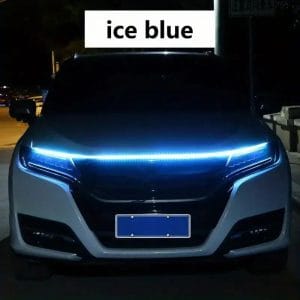
Installation Best Practices for Legal Compliance
Professional vs DIY Installation
Professional Installation Benefits:
- Ensures compliance with local regulations
- Proper wiring prevents electrical issues
- Documentation for inspection purposes
- Warranty protection for your investment
DIY Installation Considerations: If you choose to install your LED halo kit yourself, follow these guidelines:
- Use only DOT-approved components when available
- Maintain proper wire gauge and connections
- Ensure clean, weatherproof installations
- Test all functions before final assembly
Integration with Existing Lighting
Proper integration with your vehicle’s existing lighting system is crucial for legal compliance:
Headlight Function Preservation:
- Never compromise the vehicle’s original headlight performance
- Ensure proper beam patterns remain intact
- Maintain required lighting intensity levels
- Test high and low beam functionality
Electrical System Protection:
- Use appropriate fuses and relays
- Avoid overloading circuits
- Implement proper grounding
- Consider load resistors if needed
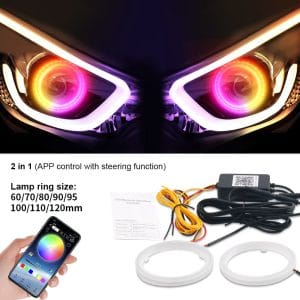
Enforcement and Penalties
Traffic Stop Considerations
If you’re pulled over with LED halo lights, here’s what to expect:
Officer Discretion: Law enforcement officers have significant discretion in enforcing lighting regulations. Factors that influence their decision include:
- Whether the lights were actively distracting
- Compliance with color restrictions
- Overall vehicle condition and driver behavior
- Local enforcement priorities
Documentation: Keep documentation of your installation, including:
- Proof of DOT compliance where applicable
- Installation receipts showing professional work
- State inspection certificates if required
- Manufacturer specifications for your LED halo kit
Potential Penalties
Penalties for illegal LED halo lights vary by state but typically include:
Minor Violations:
- Warning citations (most common for first offenses)
- Fix-it tickets requiring modification or removal
- Small fines ($25-$100 in most states)
Serious Violations:
- Larger fines for repeat offenses or dangerous installations
- Vehicle inspection failure in states requiring annual inspections
- Impounding in extreme cases involving emergency vehicle color violations
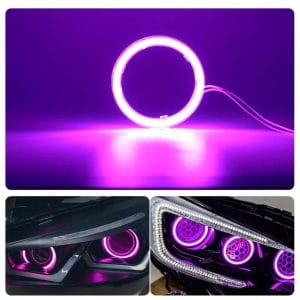
Future Legal Trends and Considerations
Evolving Regulations
As LED technology continues advancing, state regulations are slowly adapting:
Technology Integration:
- Adaptive lighting systems becoming more accepted
- Smart controls (like Bluetooth connectivity) gaining recognition
- Safety features in modern LED kits improving acceptance
Standardization Efforts: Several organizations are working toward more consistent national standards for aftermarket automotive lighting, which could simplify the legal landscape for enthusiasts.

FAQ
Q: Can I use RGB halo lights if I only display white while driving?
A: In most states, yes. Many RGB LED halo kits include programming options that allow you to set specific colors for driving mode while maintaining full RGB functionality when parked. However, verify your specific state’s regulations, as some require the removal or disabling of non-compliant color capabilities entirely.
Q: Do LED halo lights affect vehicle inspection requirements?
A: This varies by state. In states with annual vehicle inspections, properly installed LED halo lights that comply with color and brightness regulations typically don’t cause inspection failures. However, some states require documentation of professional installation or DOT compliance certifications.
Q: Are switchback LED halos (white/amber) more legal than RGB versions?
A: Generally, yes. Switchback LED halo lights that alternate between white and amber are more widely accepted because they stick to universally permitted colors. This makes them a safer choice for areas with strict lighting regulations while still providing dynamic visual appeal.
Q: Can law enforcement require me to remove legal LED halo lights?
A: If your LED halo lights comply with all applicable state and local regulations, law enforcement cannot arbitrarily require their removal. However, if the lights are malfunctioning, improperly installed, or creating safety hazards, officers may issue citations requiring corrective action.
Q: Do insurance companies care about LED halo light modifications?
A: Most insurance companies don’t specifically exclude properly installed LED halo lights from coverage. However, it’s wise to inform your insurance provider about modifications to ensure continued coverage. Some insurers may require documentation of professional installation or compliance with local regulations.
Conclusion
LED halo lights occupy a complex legal landscape that varies significantly across the United States. While many states embrace automotive customization and allow these eye-catching modifications, others maintain strict restrictions that require careful compliance.
The key to enjoying LED halo lights legally lies in understanding your local regulations, choosing compliant products, and ensuring proper installation. Whether you’re considering a high-quality RGB halo kit with Bluetooth control or simple white LED rings, research your state’s specific requirements before making your purchase.
For the safest approach, stick to white or amber LED halo lights with steady illumination patterns. These options provide maximum legal compatibility while still delivering the head-turning appearance that makes your vehicle stand out from the crowd.
Remember that the automotive lighting landscape continues evolving, with more states recognizing the safety and aesthetic benefits of modern LED technology. By staying informed about current regulations and choosing quality products from established manufacturers, you can enjoy your LED halo light investment with confidence.
Ready to transform your vehicle’s appearance while staying legal? Start by researching your state’s specific requirements, then explore professional-grade LED halo kits that offer the perfect combination of style, functionality, and legal compliance.

